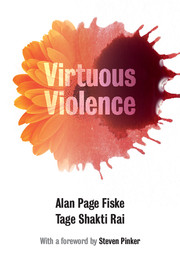Book contents
- Frontmatter
- Dedication
- Contents
- Figures and tables
- Foreword
- Warm thanks
- The point
- 1 Why are people violent?
- 2 Violence is morally motivated to regulate social relationships
- 3 Defense, punishment, and vengeance
- 4 The right and obligation of parents, police, kings, and gods to violently enforce their authority
- 5 Contests of violence: fighting for respect and solidarity
- 6 Honor and shame
- 7 War
- 8 Violence to obey, honor, and connect with the gods
- 9 On relational morality: what are its boundaries, what guides it, and how is it computed?
- 10 The prevailing wisdom
- 11 Intimate partner violence
- 12 Rape
- 13 Making them one with us: initiation, clitoridectomy, infibulation, circumcision, and castration
- 14 Torture
- 15 Homicide: he had it coming
- 16 Ethnic violence and genocide
- Chapter 17 Self-harm and suicide
- 18 Violent bereavement
- 19 Non-bodily violence: robbery
- 20 The specific form of violence for constituting each relational model
- 21 Why do people use violence to constitute their social relationships, rather than using some other medium?
- 22 Metarelational models that inhibit or provide alternatives to violence
- 23 How do we end violence?
- 24 Evolutionary, philosophical, legal, psychological, and research implications
- The dénouement
- References
- Index
Chapter 17 - Self-harm and suicide
Published online by Cambridge University Press: 05 December 2014
- Frontmatter
- Dedication
- Contents
- Figures and tables
- Foreword
- Warm thanks
- The point
- 1 Why are people violent?
- 2 Violence is morally motivated to regulate social relationships
- 3 Defense, punishment, and vengeance
- 4 The right and obligation of parents, police, kings, and gods to violently enforce their authority
- 5 Contests of violence: fighting for respect and solidarity
- 6 Honor and shame
- 7 War
- 8 Violence to obey, honor, and connect with the gods
- 9 On relational morality: what are its boundaries, what guides it, and how is it computed?
- 10 The prevailing wisdom
- 11 Intimate partner violence
- 12 Rape
- 13 Making them one with us: initiation, clitoridectomy, infibulation, circumcision, and castration
- 14 Torture
- 15 Homicide: he had it coming
- 16 Ethnic violence and genocide
- Chapter 17 Self-harm and suicide
- 18 Violent bereavement
- 19 Non-bodily violence: robbery
- 20 The specific form of violence for constituting each relational model
- 21 Why do people use violence to constitute their social relationships, rather than using some other medium?
- 22 Metarelational models that inhibit or provide alternatives to violence
- 23 How do we end violence?
- 24 Evolutionary, philosophical, legal, psychological, and research implications
- The dénouement
- References
- Index
Summary
To be, or not to be – that is the question:
Whether ’tis nobler in the mind to suffer
The slings and arrows of outrageous fortune
Or to take arms against a sea of troubles,
And by opposing end them…
For who would bear the whips and scorns of time,
Th’ oppressor’s wrong, the proud man’s contumely,
The pangs of despis’d love, the law’s delay,
The insolence of office, and the spurns
That patient merit of th’ unworthy takes,
When he himself might his quietus make
With a bare bodkin? Who would these fardels bear,
To grunt and sweat under a weary life,
But that the dread of something after death –
The undiscover’d country, from whose bourn
No traveller returns – puzzles the will,
And makes us rather bear those ills we have
Than fly to others that we know not of?
Shakespeare, Hamlet, Act III, scene i
A person may redress a wrong by harming the transgressor, or by harming someone with whom the transgressor has a vital CS relationship. Suicide and self-harm take both forms, sometimes simultaneously. Thus, Annie may kill herself because she has violated a relationship that only her self-punishment can redeem, or she may kill herself to punish Bill who has transgressed against her, but who loves her and will suffer when she kills herself. In either case there are often important metarelational motives at work. Hurting or killing oneself may restore the collective honor of one’s primary CS group, such as family or military unit. Suicide and self-harm may also show that one accepts full individual responsibility for failure, so third parties should not blame anyone else. In other metarelational processes, Annie’s suicide to punish Bill’s transgression against Annie may make George, who loves Annie, hate Bill, or at the very least shame Bill by drawing George’s and others’ attention to the gravity of Bill’s transgression against Annie. Similarly, like Lucretia’s suicide after being raped by Sextus, it may spur others to avenge a grave transgression. More recently, Tibetan monks’ suicide by setting themselves on fire to protest Chinese rule over Tibet and repression of Buddhism have put great moral pressure on China, and in 2010 Mohammed Bouazizi’s suicide by fire in Tunisia brought out masses of protestors who overthrew the government.
- Type
- Chapter
- Information
- Virtuous ViolenceHurting and Killing to Create, Sustain, End, and Honor Social Relationships, pp. 216 - 222Publisher: Cambridge University PressPrint publication year: 2014

